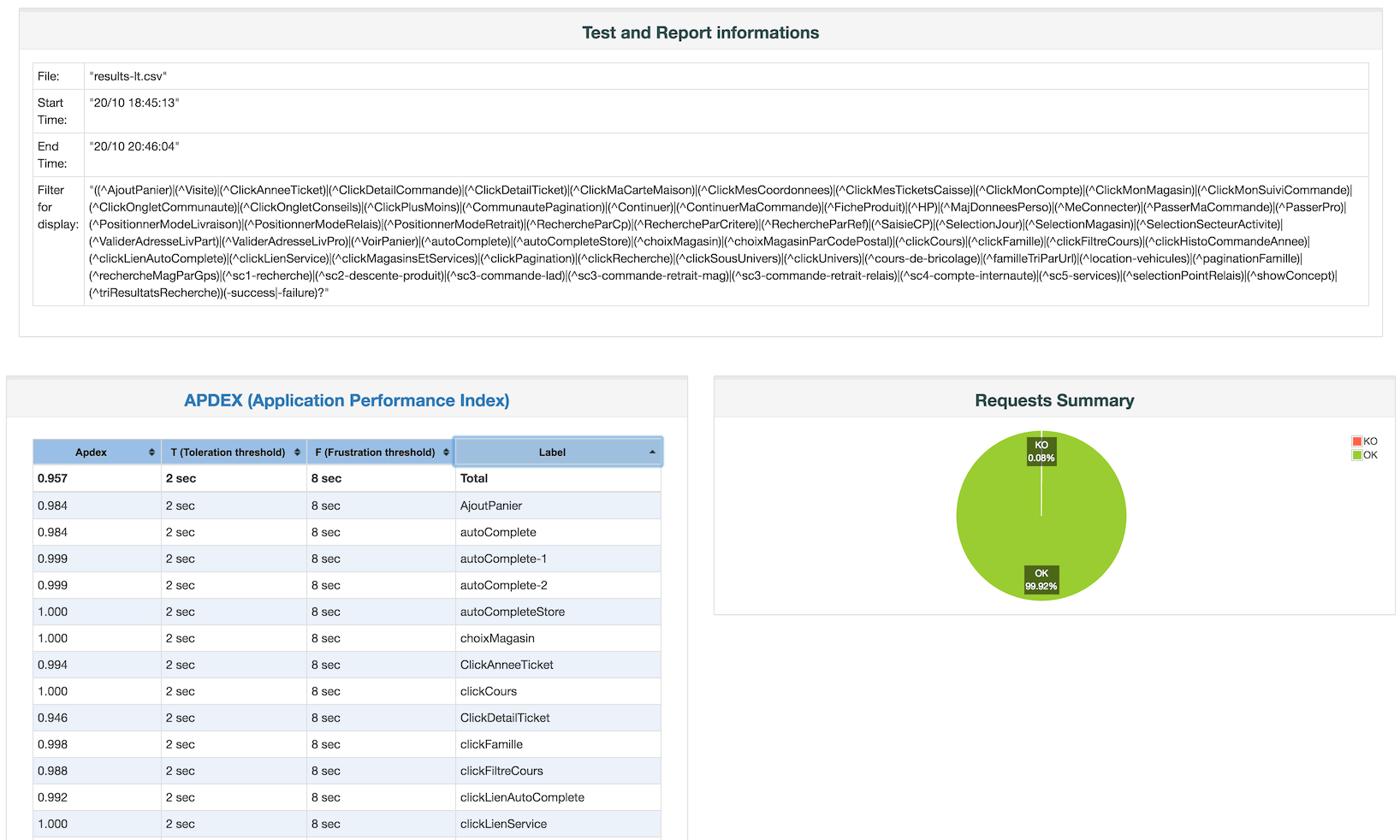Tip 9 – Generating a report from your log file
When running a performance test with Jmeter it is generally adviced to run the test in non-gui mode and to log your responses to a file. My typical command for a performance test looks something like this:
Jmeter –n –t TestScenario.jmx –j jmeter-TestRun01.log –l yyyyMMdd-TestRun-10000Threads-300TPS.jtl
Where the commandline flags have the following meaning:
-n => Non-GUI
-t => the testscenario JMX file to run as a test
-j => where to write the Jmeter logfile
-l => where to write the sample results to. This typically gets a JTL-extension
Once you have run your test successfully the real work of a performance tester starts, analyzing the outcomes and communicating the results and of course providing advice what to do with these results.
For the result-graphs you can of course use the Jmeter Listeners. You can also use Excel. But neither are a very easy nor a friendly way to do it.
Generally speaking a bit of JTL log is not very friendly to read:
timeStamp,elapsed,label,responseCode,responseMessage,threadName,dataType,success,failureMessage,bytes,sentBytes,grpThreads,allThreads,URL,Latency,Encodi
ng,SampleCount,ErrorCount,IdleTime,Connect
1504276591952,296,GET - Login screen,200,OK,jp@gc - Ultimate Thread Group - EA-OP 1-100,text,true,,523937,1116,1,1,https://poc-15.educus.nl/app/login,10
5,UTF-8,1,0,0,86
1504276592251,259,GET - Login screen,200,OK,jp@gc - Ultimate Thread Group - EA-OP 1-99,text,true,,523937,1116,2,2,https://poc-15.educus.nl/app/login,93,
UTF-8,1,0,0,77
1504276592552,282,GET - Login screen,200,OK,jp@gc - Ultimate Thread Group - EA-OP 1-98,text,true,,523937,1116,3,3,https://poc-15.educus.nl/app/login,98,
UTF-8,1,0,0,80
1504276592851,292,GET - Login screen,200,OK,jp@gc - Ultimate Thread Group - EA-OP 1-97,text,true,,523937,1116,4,4,https://poc-15.educus.nl/app/login,105
,UTF-8,1,0,0,88
1504276593151,254,GET - Login screen,200,OK,jp@gc - Ultimate Thread Group - EA-OP 1-96,text,true,,523937,1116,5,5,https://poc-15.educus.nl/app/login,97,
UTF-8,1,0,0,80
1504276593451,212,GET - Login screen,200,OK,jp@gc - Ultimate Thread Group - EA-OP 1-95,text,true,,523937,1116,6,6,https://poc-15.educus.nl/app/login,87,
UTF-8,1,0,0,72
1504276593751,225,GET - Login screen,200,OK,jp@gc - Ultimate Thread Group - EA-OP 1-94,text,true,,523937,1116,7,7,https://poc-15.educus.nl/app/login,89,
UTF-8,1,0,0,73
1504276594051,210,GET - Login screen,200,OK,jp@gc - Ultimate Thread Group - EA-OP 1-93,text,true,,523937,1116,8,8,https://poc-15.educus.nl/app/login,90,
UTF-8,1,0,0,74
1504276594351,214,GET - Login screen,200,OK,jp@gc - Ultimate Thread Group - EA-OP 1-92,text,true,,523937,1116,9,9,https://poc-15.educus.nl/app/login,88,
UTF-8,1,0,0,73
1504276594651,228,GET - Login screen,200,OK,jp@gc - Ultimate Thread Group - EA-OP 1-91,text,true,,523937,1116,10,10,https://poc-15.educus.nl/app/login,9
1,UTF-8,1,0,0,75
Thankfully JMeter has a very nice, although not very elegant solution to this. I consider this not very elegant since you can only trigger it via commandline. The results however are quite elegant and pretty to view.
Run the following command to get your pretty report once your test is finished:
jmeter -g yyyyMMdd-TestRun-10000Threads-300TPS.jtl -o WriteThisToACleanDirectory
This generates a very nice HTML/js based reporting dashboard. I will refrain from going into details about how nice the dashboard has become over the years, you can read all that is in the dashboards on the Apache Jmeter site.
The landing page may look something like this:

The graphs on the dashboard are all ineractive, you can zoom in on specific details, filter out specifi requests etc. I really like what has become of these reports.
The negative side of that way of generating a report is that you still have to do it once you are done running your performance tests.
That too can be solved! When running tests from a commandline I generally use a command close to this:
jmeter -n -t TestScenario.jmx -j jmeter-TestRun01.log -l yyyyMMdd-TestRun-10000Threads-300TPS.jtl -e -o OUTPUTDIRECTORY > /dev/null 2>&1 &
The addition of the dashboard generation is done with the
-e -o OUTPUTDIRECTORY
flags and arguments. The little extra sauce I give is that I generally open a second console where I tail the JMeter log and potentially the JTL log. So in my main window, where I started the testrun, I prefer to have my commandline available to do useful things such as shutdown JMeter if so required. Hence I send the console output to
/dev/null
and send any possible error stream directly to the output stream (which again is sent into the void that is /dev/null
Last but not least I background the process with the & in order for me to have my console back and available.



